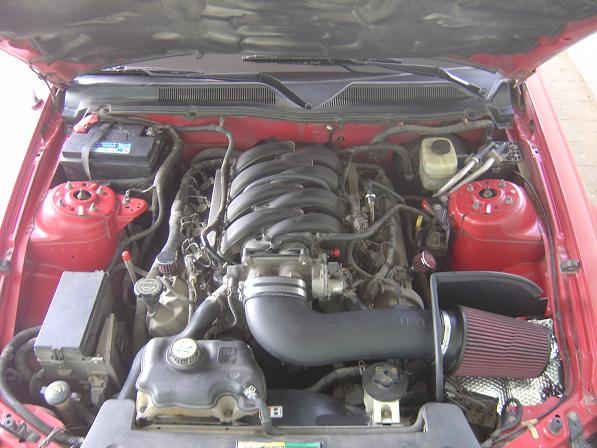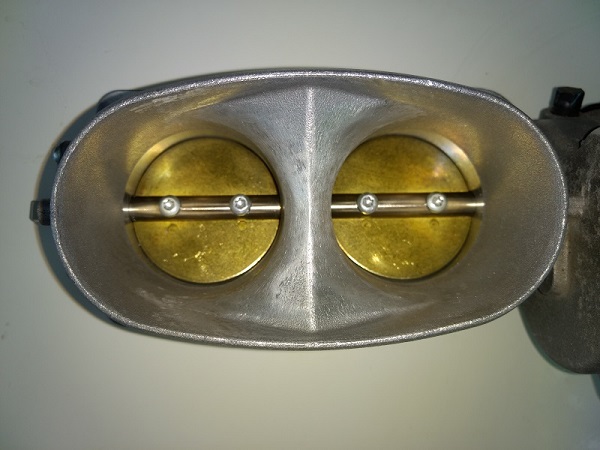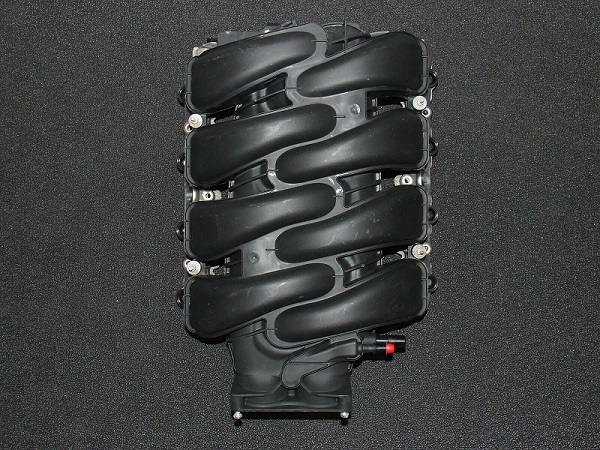Intake System
Home | Intake | CMDP | UDP | Exhaust | Suspension | Interior | Aerodynamics | Parts | Dyno | Bolt Ons | Engine | Coyote SwapThe stock air filter assembly is the most restrictive component of the intake system even without the hydrocarbon trap (flows only 550cfm @ 28" H2O depression) so there's plenty of room for improvement. Unsurprisingly the most popular entry level performance upgrade is an aftermarket cold air intake kit with handheld PCM programmer.
 JLT Series 3 Cold Air Intake
JLT Series 3 Cold Air Intake
The JLT series 3 110mm CAI is the most free-flowing CAI kit available (estimated to be a whopping 1435cfm @ 28" H2O depression) and I bought that together with an SCT X3 handheld tuner. Installing the JLT CAI and uploading the Brenspeed 91 octane (95 RON) tune into the car's PCM was a breeze. The engine immediately felt more responsive and the low rpm "lag" of the drive-by-wire throttle was gone. There was a noticeable induction roar when pressing on the throttle which, when combined with the soundtrack of the engine, was very intoxicating! Acceleration through the gears was noticeably stronger, especially in 5th gear at highway speeds, making the car so much more fun to drive.
Chassis dyno tests of otherwise stock '05-'09 S197 GTs with the same cold air intake & 91 octane tune yield an average of 289hp & 303lbft. These figures translate into 331hp & 344lbft at the crank. Peak HP is a plateau from 5300-6200rpm and peak TQ arrives at 4300rpm. The stock 6250rpm rev limiter is conservative, and the increased high rpm breathing ability of the JLT CAI allows it to be raised to 6500rpm.
 Ported Throttle Body
Ported Throttle Body
Maximum airflow at WOT (stock TB): 953cfm @ 28" H20 depression
Bore diameter at throttle butterflies: 55mm (dual)
Throttle shaft diameter: 10mm
Total c/s area at WOT: 5.66 sq. in.
Maximum airflow velocity (stock TB): 404 ft./min. @ 28" H20 depression
The maximum airflow of the stock throttle body is theoretically enough to feed an engine putting out 635hp or roughly twice the output of a N/A 4.6L 3V engine. However the center divider of the throttle body is wide, with sharp edges at the top of each bore that induce airflow turbulence. I feathered the edges at the top of each bore and blended them into the center divider, streamlining the airflow path down the inner side of each bore thus allowing more laminar flow. The increased air velocity sharpens throttle response and produces a small HP/TQ gain.
If you're handy using a Dremel, this is an easy modification to perform, plus it's free if you already have a carbide cutter and sanding rolls.
 Intake Manifold With CMCV Delete
Intake Manifold With CMCV Delete
Total intake manifold volume: 10.9 litres
Plenum volume: 6.1 litres
Plenum opening diameter: dual 62mm
Runner c/s area: 2.625 sq. in.
Peak airflow per runner @ 28" H2O depression (CMCVs deleted): 250-260cfm
Reflective wave tuning with stock camshaft (3rd harmonic): 5900rpm (at peak HP)
Reflective wave tuning with stock camshaft (4th harmonic): 4400rpm (at peak TQ)
The stock EFI intake manifold is a lightweight composite single-plenum cross-ram unit with fixed 14" length runners that are tapered to increase airflow velocity for optimum combustion efficiency. Ford did an excellent job designing a low cost manifold that maximizes the runner length as much as possible for good low rpm torque production while allowing sufficient clearance under the hood. A variable length intake manifold design would have been ideal for optimizing volumetric efficiency over a wider rpm range but this wasn't possible given the space constraints. Ford chose instead to incorporate computer-controlled charge motion control valves (CMCV) into the intake manifold runners with the aim of minimizing cold start and low rpm hydrocarbon emissions. Unfortunately these have their drawbacks and since deleting them is a popular modification, I also chose to do so with very good results (see next page).
Indeed a stock intake manifold with CMCV delete is efficient enough to outflow the intake ports of the stock cylinder heads by ~25cfm and continue making power up to ~6300rpm. It'll even support up to ~380rwhp (~430hp crank) and a 6800rpm rev limit on a stock 4.6L short block with stage 3 CNC ported heads and SPR camshafts. Therefore there's no need to switch to a shorter runner aftermarket performance intake manifold unless you plan to increase the engine's rev limit to 7000+rpm.